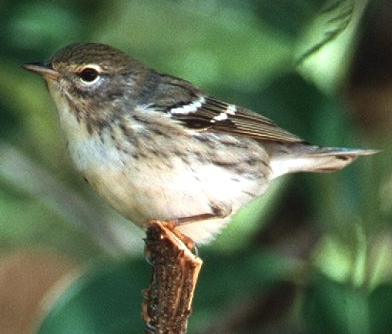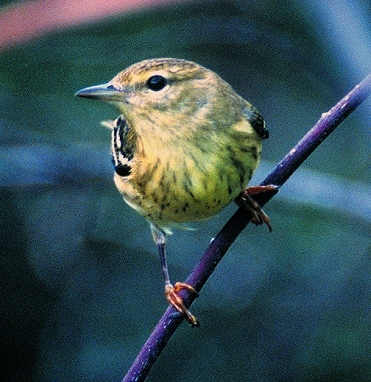|
Blackpoll Warbler Dendroica striata Reinita Rayada,
|
 |
|
Female - Photo: B. Hallett
|
|
Blackpoll Warbler Dendroica striata Reinita Rayada,
|
 |
|
Female - Photo: B. Hallett
|
|
IDENTIFICATION: In the breeding season, the male has a dramatic black and white pattern with a black cap and white cheek patches (see photo below). The female and non-breeding plumages are dull gray-brown with two white wing bars and a faint yellow breast (see photo above) much like the winter plumage of the Bay-breasted Warbler. Length: 13-14 cm.; weight: 12-13 g. VOICE: A sharp chip note given often during migration. Audio (M. Oberle). On the breeding grounds the male sings a series of rapid notes all on the same high pitch. In fact, the song is so high-pitched that many humans have trouble hearing it. HABITAT: In Puerto Rico it is found in gardens, coastal areas and dry forest. HABITS: Gleans insects and spiders off leaves and less commonly eats small fruits. On its breeding grounds in North America the female builds a nest hidden in a coniferous tree. She does all the incubating of the 3-5 eggs while the male sings nearby. The female broods the young but both parents feed the chicks. The chicks fledge 9-10 days after hatching. Some males have more than one mate in a season. The Blackpoll has a very distinctive fall migration route: it flies east across North America to Canadaís Maritime Provinces and then flies over open ocean to winter grounds in northern South America. This migration sometimes takes three days over water although the birds try to time their migration to take advantage of favorable winds. STATUS AND CONSERVATION: An irregular fall migrant. In some years, winds blow large numbers of this species to West Indian islands. The return migration is farther west over Cuba and the Gulf of Mexico, so it is less common in Puerto Rico in spring migration. Some Blackpoll Warblers may overwinter in the West Indies. RANGE: Breeds in boreal forests from Alaska to northern New England. Winters in northwestern South America and the Amazon basin, south to northern Bolivia. TAXONOMY: PASSERIFORMES; PARULIDAE |
|
 |
|
Female - Photo: B. Hallett
|
 |
|
Breeding male -
Photo: R. Zaremba |
 |
|
Breeding male - Photo: G. Beaton
|
 |
|
|
Non-breeding - Photo: D. Roberson
|
|
References Arendt, W.J. 1992. Status of North American migrant landbirds in the Caribbean region: a summary. Pp. 143-171 in Ecology and conservation of neotropical migrant landbirds (J.M. Hagan III and D.W. Johnston, eds.) Smithsonian Instit. Press, Washington, D.C. Baird, J. 1999. The epic autumn flight of the Blackpoll Warbler. Birding 31(1):65-73. Bent, A.C. 1953. Life histories of North American wood warblers. Smithsonian Instit. U.S. National Museum Bull. 203. (Reprinted by Dover Press, NY, 1963). Dunn, J. and K. Garrett. 1997. A field guide to warblers of North America. Houghton Mifflin, NY. Ehrlich, P.R., D.S. Dobkin, and D. Wheye. 1988. The birderís handbook: a field guide to the natural history of North American birds. Simon and Schuster/ Fireside, NY. McNair, D. B., W. J. Arendt and E. Massiah. 1996. Sightings of the Blackpoll Warbler in the West Indies during winter. Florida Field Nat. 24:81-82. Raffaele, H.A. 1989. A guide to the birds of Puerto Rico and the Virgin Islands. Princeton. Raffaele, H.A. 1989. Una guía a las aves de Puerto Rico y las Islas Vírgenes. Publishing Resources, Inc., Santurce, PR. Raffaele, H.A., J.W. Wiley, O.H. Garrido, A.R. Keith, and J.I. Raffaele. 1998. Guide to the birds of the West Indies. Princeton. Blackpoll Warbler, Spanish text Next related species in taxonomic order Previous related species in taxonomic order |
|